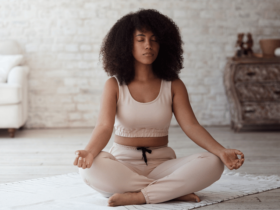We live in a society where dealing with anxiety and stress has become one of the daily duties. This makes it even more important to search for and implement techniques to de-stress. Yoga is one of those disciplines that focuses on the element of stress relief through practiced breathing techniques, postures, and meditation. Here we will delve deeper into how the basic techniques and fundamentals of yoga can help relieve stress and help people regain inner peace and calm mind even when tackling tough loaded days. These tips can be integrated into your day regardless of whether you have just started practicing yoga or have been doing it for quite a long time.
Practicing Stress Management for a Calm Mind
Stress is a leading factor in the deterioration of an individual’s mental and physical health. Being overly worried about something, feeling anxious, or being restless all the time can lead to several outcomes such as sleep deprivation or even worse, a setback in normal cognitive functioning. Based off statistics from the American Psychological Association, over 70% of adults in the US are under a significant amount of stress hence finding and applying reliable techniques to manage stress is of utmost importance.
Yoga is not limited to physical exercise form, it encompasses more, in the sense, it’s a unique methodology which focuses on both the mind and the body. Yoga involves a range of activities, such as breathing, stretching, and meditation, which help in achieving relaxation, freeing the mind, and learning how to be more in the present. Stress can have a profoundly negative impact on our physical and mental health, but as a way of managing stress yoga provides a degree of calm that lights focus and elevates creativity levels as well as emotional stability.
The various aspects of the mind can be adjusted with the help of Yoga. In the following sections, we will look into the 10 approaches and techniques from the world of yoga that would help you gain peace of mind and tackle stress in a more calm way.
10 Powerful Ways to Keep Your Mind Peaceful with the Help of Yoga
Deep Breathing (Pranayama)
Breathing exercises or pranayama are the key concepts of yoga. Pranayama or breathing techniques are a great way to stimulate the pelvic nerves and develop the muscles that control the sphincters and voiding reflexes. These breathing patterns help reduce heart rates and stress levels. Tranquility develops in the mind as a consequence.
Suggestion: To soothe the nerves, use Nadi Shodhana (alternate nostril breathing). It uses alternate breathing techniques through each nostril, which not only calms the mind but also promotes the harmonious balance of energy in the body.
Mindfulness Meditation
This last and the most important step is more psychological in nature than it is physical, and that is the essence of meditation. One such technique is breathing itself, or there are mantras. There are plenty, perhaps thousands of mantras you can use to enter into a meditative state. Which in essence brings about the phenomenon of creating one-pointedness, peace and tranquility in limitless world without being attached or biased with anything.
Tip: For the absolute beginner sitting in meditation for more than 30 minutes can come across as difficult, so I suggest the best way to make it easier is to put a timer for breathing. In the course of time, improvement will be noticed in terms of reduction of anxiety and an increased ability to remain firmly centered during stimulating situations.
Gentle Asanas (Postures)
With regards to regulation and assistance to the patient, it is important to note that the level of complexity and the range of motion of the stretching exercises the therapist uses in stretching broaden as finishing stages of therapy side approach. Some yoga postures have broad impact on the psyche, especially the ones that involve gentle stretching and relaxation, such as Child’s Pose (Balasana), Cat – Cow (Marjaryasana-Bitilasana), and Legs up the wall (Viparita Karani) which relieve the physical body and relax the overactive mind.
Tip: I would suggest doing such gentle yoga poses before bed to calm down and relieve stress allowing for falling asleep. Time should not exceed 10 minutes. Taking off tension from the body and mind requires even a 10-minute session.
Yoga Nidra (Yogic Sleep)
Guided meditation techniques widely and wrongly referred to as ‘Yogic Sleep’ – Yoga Nidra involves functioning in such a manner where someone remains fully aware while you logically redirect them to deliberately suppress all activities and tensions in the body resulting in an intermediary state between feeling sleepy and being awake. In this state, one not only is able to rest but in addition to abating stress, it helps one deal with deeply embedded tensions and worries.
Recommendation: To see improved calming and clarity of your mind, try doing 20 to 40 minutes of Yoga Nidra at least once or twice a week.
Focused Attention (Dharana)
Dharana, in the context of yoga, encompasses a fountain of concentration on a narrow area in people for instance, a neutral expression that they need to maintain in order to practice yoga. This inspired point then moves towards guiding individuals on controlling and attending to thoughts in their head until everything becomes quiet.
Recommendation: Consider concentrating on your breathing; or take a few moments to mentally repeat ‘Om’ or the word ‘peace’ to soothe your mind. Such techniques are particularly useful and potent when during feelings of stress or distraction.
Restorative Yoga
Postures in restorative yoga are held longer with the support of bolsters and blankets that aid classical yoga poses. This certainly seems to promote relaxation and allows for the psychological nervous system to facilitate profound relaxation throughout the body.
Recommendation: Consider a restorative class for deep tension to be released or do a few poses at home with props to aid relaxation in the mindfulness of your practice.
Vinyasa Flow in Releasing Stress
Vinyasa yoga may be more active. However, the transitions from one pose to another can also be soothing if done intentionally. Pacing your breath with every motion is an essential factor. As this promotes a more relaxed and clearer state of the mind.
Tip: Create a short flow sequence using sequences of breath. As you connect Downward Dog (Adho Mukha Svanasana) to Forward Fold (Uttanasana). Deep breaths can ease any tension out of the body and allow for a more tranquil state during transitions.
The Use of Affirmations in Yoga Practice
One of the things yoga promotes is the use of affirmations. Which are words you say to yourself so as to think positively. For instance, saying, “I am relaxed and at ease” repeatedly can retrain the brain to handle stress in a more composed fashion.
Tip: Add affirmations in your yoga by saying them inside your head before a session or after one. This can help in adding some positivity or calmness in one’s life.
Yoga to Get Sleep (Yoga and Relaxation Techniques Before Sleeping)
Sleep is necessary for proper mental function. Insufficient sleep can worsen a person’s mood and increase their level of stress. Several yoga positions can enhance sleep quality by activating the parasympathetic nervous system and also relaxing the body.
Tip: Gently reposition yourself using the Reclined Bound Angle or Corpse poses. Alongside this, focus on deep breathing. Which will help ease any tension you might be having, thus, allowing you to sleep better.
Practicing Gratitude
Apart from being mindful of their body and breath, yoga practitioners also sway their attention to their surrounding environment. Practicing gratitude helps you refocus from obsessive negativity to the present moment where calmness and peace reside.
Tip: Take a few minutes after every yoga session to appreciate things past and present. You be surprise at how this simple practice helps you in being more positive and peaceful.
Best Known Methods for Clearing Your Head
Apart from achieving mental clarity through these yoga techniques, here are a few quick notes to assist you in maximizing your practice:
- Do it Repeatedly: Mental gain, similar to the physical one, entails regular effort. Even if it is for 10-15 minutes, start incorporating yoga into your day-to-day activities and expand your horizons.
- Lift Every Time Through Relaxation: With every start of a yoga session, visualize an image you want to achieve or note an act you want to do. Which in turn will assist you in lessening stress or increasing focus.
- Create a Calm Room: Set up a room that is quiet and peaceful where you can do your yoga. This can help the voice in your brain understand that it’s the right time to shed off all the stress. And focus on relaxation.
Conclusion of Perspectives
Day by day, stress increases in one form or the other and yoga is an excellent way of calming your mind. The simple techniques of breathing control, meditation, and easy and balanced movements bring about peace and calmness around you. Try to do it daily for a few minutes and see how yoga changes your way of relaxation in a precise manner.
Have you tried any of these techniques? Which has been the best for you to help in finding a calm mind? Leave your comments in the section below to share your experience or read about more yoga guides to improve your practice!















2 Comments
View Comments